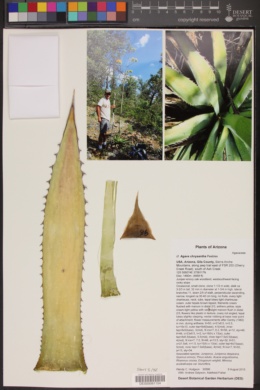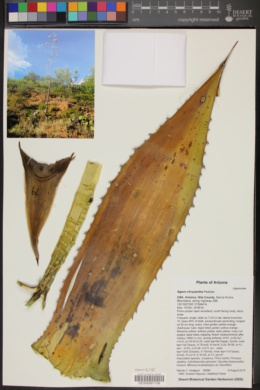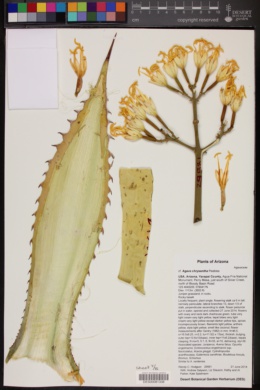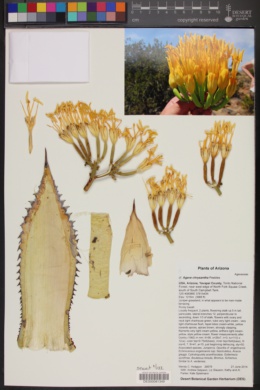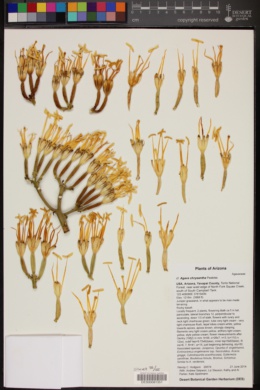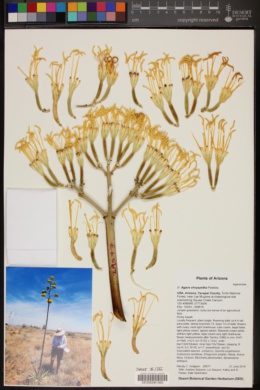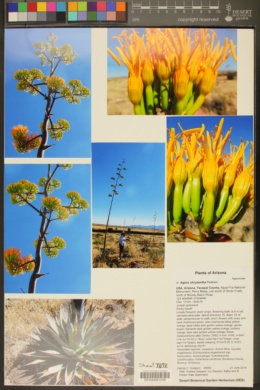Agave chrysantha
|
|
|
|
Family: Asparagaceae
Golden-Flower Century-Plant, more...goldenflower century plant, golden-flowered agave, golden flowered agave (es: maguey)
[Agave palmeri var. chrysantha (Peebles) Little ex L. Benson] |
Plants acaulescent, occasionally suckering; rosettes solitary or infrequently cespitose, 0.5-1.2 × 0.8-1 dm, rather open to somewhat dense. Leaves spreading to ascending, 40-75(-82) × (4-)8-10(-11) cm; blade pale to glaucous or yellowish green to green, not cross-zoned, linear-lanceolate to lanceolate, rigid, adaxially deeply guttered, abaxially convex; margins undulate to wavy, armed, teeth single, well defined, 4-10 mm, (0.8-)1-3(-4) cm apart, interstitial teeth (0-)1-3(-5), mostly along distal 2/3 of margins; apical spine reddish brown or brown to gray, acicular, 2.5-4.5 cm. Scape 4-7 m. Inflorescences narrowly to broadly paniculate, open, not bulbiferous; bracts persistent, triangular, 1-5 cm; lateral branches (6-)8-18, slightly ascending, comprising distal 1/4-1/3 of inflorescence, longer than 10 cm. Flowers 12-21 per cluster, erect, 3.5-6.5(-6.7) cm; perianth golden yellow, tube not shallow, campanulate, 6-18 × (7-)10-21(-26) mm, limb lobes erect persistent and often leathery during and after anthesis, strongly unequal, (6-)9-15(-18) mm; stamens long-exserted; filaments inserted at 2 levels ca. mid perianth tube, erect, pale yellow, (3.2-)3.5-5 cm; anthers yellow, 7-20 mm; ovary (1.4-)2.2-3(-3.3) cm, neck slightly constricted, (0.5-)4-6(-8) mm. Capsules sessile or short-pedicellate, narrowly oblong to obovoid, 3.5-5 cm, apex short-beaked. Seeds 6-7 mm. 2n = 60. Flowering late spring--summer. Sandy to gravelly places on granitic or volcanic soils in desert scrub, grasslands, pinyon-juniper, and oak woodlands; 700--2100 m; Ariz. Agave chrysantha hybridizes with A. murpheyi, A. palmeri, A. parryi var. couesii, and A. delamateri.
Plant: perennial scapose herb; Rosettes single or infrequently caespitose, open, ca. 0.5-1.2 m high, 0.8-1 m broad Leaves: highly variable, numerous, 40-82 cm long, (4.1-)4.8-11 cm wide, broadest at middle, lanceolate, acuminate, spreading-ascending, rigid, deeply concave towards apex, thick and convex towards base, glaucous gray to yellowish green to deep green, the margins straight to repand; teeth variable, brown to gray, the larger ones 4-10 mm long, straight, reflexed, or deflexed, firmly attached, (0.8-)1-3(-4) cm apart; interstitial teeth (0-)1-3(-5) on upper - of leaf margin; terminal spine 2.5-4.5 cm long, slender, openly grooved above, brown to gray, decurrent for 5-15 cm to upper teeth INFLORESCENCE: with scape 4-7 m tall, narrowly to broadly paniculate, of (6-)11-17 lateral ascending branchlets in upper 1/4 of flowering stalk, the longer ones 20-39 cm long, the shorter ones 3.2-12.2 cm long, the stalk thick, green to glaucous Flowers: congested in umbels, 35-67 mm long, durable, cylindric-urceolate, with a strong sweet-musky fragrance at anthesis; tepals erect, clasping the filaments, thick, drying leathery, persisting erect, unequal, the outer ones 8-18 mm high, 5-10 mm broad, the inner ones 6-14 mm high, 3-9 mm broad, golden-yellow with brown-corneous hooded tips; filaments 32-55 mm long, inserted at 2 levels, 3-10 mm and 4-11 mm above base of tube, light yellow, the anthers 7-17(-20) mm long, yellow; ovary 14-33 mm long, slender, rounded, with short, constricted neck 0.2- 4(-8) mm long, lime-green, the style 21-52 mm long when stigma is receptive, light yellow; floral tube 6-18 mm long, (7-)12-21(-25) mm wide, bulging somewhat at base of tepals, light lime-green Fruit: a loculicidal capsule, congested, 35-50 mm long, 13-15 mm broad, linear oblong to obovoid, apiculate; SEEDS black, 6-7 mm long, 4.5-5 mm broad, with marginal wing Misc: Open rocky slopes in high desertscrub, chaparral, and juniper grassland; 700-2150 m (2300-7000 ft); May-Aug REFERENCES: Hodgson, Wendy. 1999. Agavaceae. Ariz. - Nev. Acad. Sci. 32(1). Gentry 1982, FNA 2006 Common Name: goldenflower century plant Duration: Perennial Nativity: Native Lifeform: Succulent General: Perennial scapose succulents, small compact rosettes to large and open, grayish to yellowish green 0.5-1 m tall, 0.8-1.8 m wide, usually single, infrequently suckering. Leaves: Linear-lanceolate to lanceolate, usually narrowed below middle, widest in middle, straight, deeply guttered, margin nearly straight to repand, 40-75 by 8-10 cm; larger teeth 1-3 cm apart, 5-10 mm long, straight or flexed, smaller teeth toward base and interstitial; slender spine, 25-45 mm long, brown to gray in age. Flowers: Panicles 4-7 m tall, small, narrow, with 8-18 small congested umbels in upper quarter to third of shaft; yellow flowers, 40-55 mm, ovary 22-30 mm long, slender with short constricted neck; tube 8-13 mm deep, 10-12 mm wide with bulging angles, narrowly grooved, thick-walled; dimorphic tepals, thick, 9-15 mm long, shorter to longer than tube, rarely red tipped. Fruits: Capsule, 35-50 mm by 13-15 mm, linear oblong to obovoid, apiculate, walls thin. Ecology: Found on granitic and volcanic mountain slopes from 3,000-6,000 ft (914-1829 m); flowers spring-summer. Notes: This species is thought to be the halfway species between A. palmeri and A. parryi, appears to be more closely related to A. palmeri (Gentry 1982). Ethnobotany: Unknown, but other species in genus have many uses. Etymology: Agave is from Greek agauos, admirable, noble, while chrysantha means with golden flowers. Synonyms: Agave palmeri var. chrysantha Editor: SBuckley, 2010 |
|
|
|













